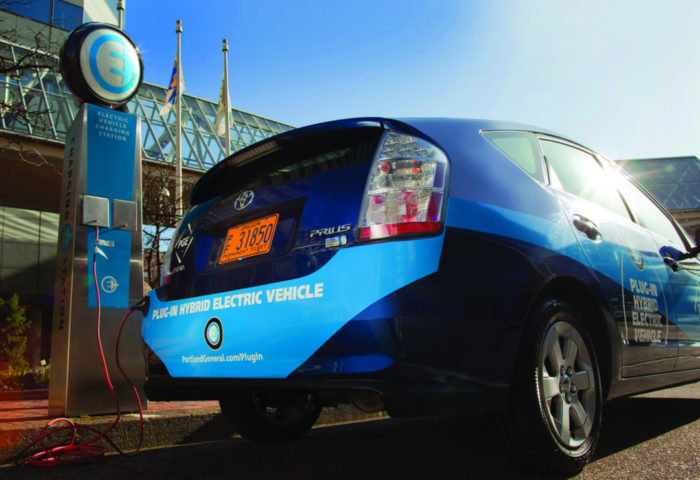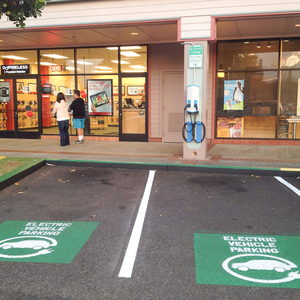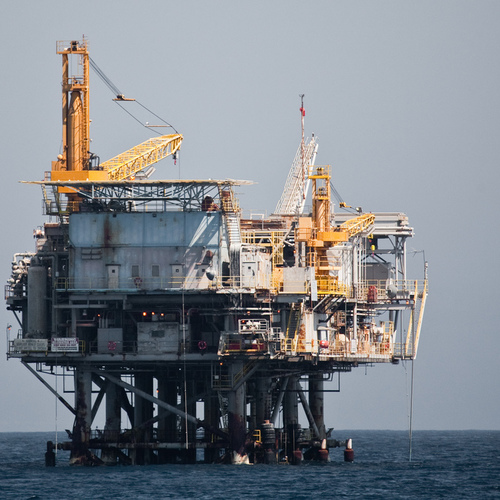
Image Credit: Portlandgeneralelectric / CC BY-ND / Flickr
Retail gasoline prices are now as low as they were in the “roaring ‘90s.” The 1990s, that is, when the energy crisis of the 1970s had faded from American consumers’ memories, the economy was strong and the market share of sport utility vehicles (SUVs) had more than tripled over the decade.
As in the 1990s, low-cost gasoline is changing consumers’ habits, encouraging them to drive more and purchase less fuel-efficient vehicles. What’s different now is that U.S. automakers face far more stringent fuel-economy standards. The rules, which require automakers to have a fleet-wide, on-road average of roughly 40 miles per gallon by 2025, are the country’s primary policy for reducing carbon dioxide (COâ‚‚) emissions from motor vehicles.
However, fuel prices have plummeted since these rules were put in place. What does cheap gasoline mean for the country’s progress in reducing emissions?
To answer this question, we need to look at the interplay between gas prices and consumer behavior. We also need to consider the impact that technology and policy can have – and cannot have – on reducing emissions from motor vehicles.
Déjà vu all over again
When pump prices are high, consumers are motivated to drive less and choose fuel-efficient vehicles. As prices moderate, there is a weaker financial motive to economize on gas, making emissions reduction more difficult. This puts a greater burden on policy to sustain progress in spite of consumer disinterest.
Petroleum is the largest source of COâ‚‚ emissions in the United States and, after coal, the second largest globally. Petroleum use is driven by demand for motor fuels, of which cars and personal light trucks consume the largest share. Because a car’s COâ‚‚ emissions are directly linked to its fuel economy, any gain in fuel efficiency results in lower COâ‚‚.
For example, an SUV that gets 20 mpg emits 5.3 metric tons of COâ‚‚ during a typical 12,000 miles per year of driving, while a 30 mpg sedan emits 3.6 tons to cover the same distance.
For over a year now, the national average fuel price has been much lower than the roughly $3.50 per gallon average of the previous few years, let alone the brief spike to over $4.00 per gallon in summer 2008.
The University of Michigan Energy Survey’s affordability index earlier this year found that consumers feel gasoline is twice as affordable as it was before oil prices began sliding in mid-2014.
It’s no surprise, then, that new vehicle sales are at a record high while the sales mix has shifted away from compact segments and back to trucks, larger SUVs, and more luxurious cars.
The amount of driving is up again as well. We’ve seen this situation before when the energy crisis of a generation ago gave way to a resumption of consumption after oil prices tumbled in 1986.

The adjoining graph compares the average fuel economy of new cars and light trucks to the nominal (“dollars of the day”) and real (inflated to 2015 dollars) price of gasoline since 1970. As the graph shows, fuel economy ratchets up as fuel prices rise. Conversely, low and stable fuel prices can cause fuel economy to backslide, which occurred from the late 1980s until a decade ago.
During the 1990s, overall vehicle efficiency eroded as consumer tastes and automaker sales strategies fostered a shift to light trucks (vans, SUVs, and pickups), which are regulated more leniently than the cars (sedans, coupes, and station wagons) they displaced.
A similar shift is again under way now, reflecting the tension between consumer buying habits and the need to cut carbon.
Technology and importance of scale
The relation between technology and efficiency, meanwhile, is more subtle than it might seem to observers outside the industry.
The graph seems to suggest that technological progress for better fuel efficiency happened in spurts triggered by periods of rising fuel price.
In fact, as measured by engineering metrics, the rate of technology change has been remarkably steady throughout this whole time period from the 1970s to date, as documented in a paper I coauthored a decade ago and confirmed more recently by colleagues from MIT. That is to say, automakers are continually improving the engineering of vehicles whether or not the improvements are used to raise fuel economy.
In other words, regardless of the fuel price situation, there is always a latent potential to improve efficiency as vehicles are routinely redesigned and new models are introduced. But the extent to which the potential is realized depends on the priority given to higher fuel economy relative to other features customers value and automakers can readily sell.
This means that modest changes in how much consumers prioritize fuel efficiency can significantly affect COâ‚‚ emissions, for either better or worse. If millions of consumers choose a larger or smaller vehicle, or select a higher or lower horsepower engine, it will have a far greater impact than a small niche of eco-minded consumers who purchase battery-electric or hydrogen vehicles.
Whither electric vehicles?
In an interview about recent auto market trends, U.S. Secretary of Energy Ernest Moniz conceded that electric vehicle (EV) sales were well behind the Administration’s goal of putting a million plug-in cars on the road by last year. Moniz seemed unconcerned about the shift back to SUVs and instead emphasized the importance of a “long-term view.”
How do slowing sales of EVs, due at least in part to cheap gasoline, affect emissions?
It is instructive to compare the effect of mainstream market shifts to the sales of EVs such as the Nissan Leaf (a battery-only car) or Chevy Volt (a plug-in hybrid with a small gasoline engine to extend its range). The EV market got a boost in 2008, which saw the launch of the high-profile Tesla Roadster along with spiking oil prices.
Bolstered by tax credits and other generous subsidies, plug-in car sales grew rapidly and there are now over two dozen models available that charge from the electric grid for some or all of their energy. EV sales reached just over 122,000 by 2014, but have since fallen in the face of lower fuel prices, dropping to 116,000 in 2015 even as overall auto sales hit a new high.
EVs directly emit no COâ‚‚ when running on battery power alone. Accounting for power plant emissions but recognizing that most EV sales have occurred in California and other states with cleaner-than-average electric grids, the typical electric car emits only about one-fourth of the COâ‚‚ of a similarly sized gasoline car.
Based on that assumption and sales data, I estimate that the new EVs sold in 2015 cut COâ‚‚ emissions by roughly 0.26 million metric tons per year.
On the other hand, the market share of vehicles that EPA classifies as light trucks for regulatory purposes rose from 33 percent to 40 percent over the past six years. That seven-point shift from relatively efficient cars to less efficient light trucks implies a COâ‚‚ emissions increase of 1.76 million metric tons per year, more than six times the emissions reduction from EVs.
In other words, waning interest in fuel economy across the mainstream market slows climate progress much more than lagging sales of electric cars.
Social challenge
Unfortunately, efforts to promote more fuel-efficient vehicles across the entire market are not nearly as robust as the social marketing, to say nothing of monetary incentives, directed at the electric and other alternative fuel niches.
A 2013 study published by the National Academy of Sciences (for which I was a committee member) concluded that even for several decades ahead, the most substantial and lowest-cost ways to cut automobile COâ‚‚ emissions will still be ongoing improvements of gasoline vehicles. The study also found that even with good progress in battery technology, it will not be feasible to electrify most SUVs and other light trucks, which emit a disproportionate amount of COâ‚‚. Trying to run larger vehicles from a battery results in a vicious cycle of heavier weight and higher costs that would render the resulting vehicle both impractical and exorbitantly expensive.
Automakers are regulated by a combination of Corporate Average Fuel Economy (CAFE) standards and greenhouse gas (GHG) emissions standards, which, relative to the 2015 level, target a further 40 percent cut in the new fleet-average COâ‚‚ emissions rate of both cars and light trucks by 2025. A National Academy study published last year found that ample technology is available to meet the 2025 target.
As these regulations come up for review next year, the greater challenge will be weak consumer interest in efficiency, which makes it more profitable for automakers to offer still higher horsepower, larger vehicles, and other features that trade off against fuel economy.
The question, then, is whether ways can be found to bolster consumer interest in fuel economy for environmental rather than economic reasons, so that progress can be maintained even when fuel prices are low.
Indeed, the misalignment between consumer interest and the need for ongoing efficiency gains may only grow in the years ahead. Periods of high oil prices are likely to be transient for the foreseeable future if not indefinitely. This situation will require new approaches by policymakers, automakers, and environmental advocates, as well as creative social science research.
Successfully confronting the social challenge of encouraging consumers to prioritize fuel efficiency – across the broad market of gasoline-powered personal vehicles – will open the door to greater progress on the car part of the climate challenge than can be achieved through technology alone.
John DeCicco is a research professor at the University of Michigan. This post originally appeared at The Conversation.
Weekly Newsletter
Get building science and energy efficiency advice, plus special offers, in your inbox.















16 Comments
Is this the foil to this article from not too long ago on GBA?
“How Low Oil Prices Can Be Good for the Environment”
I'd like to see some hard numbers
The demand for transportation is basically inelastic. People still have to drive from X to Y every day regardless of gas prices. If the annual miles driven has increased substantially then I would want to see that broken down on a monthly basis so we can determine if the increase is due to people opting for family vacations and not a daily increase in miles. These numbers can be nailed down even further by looking at airline passenger data over the same periods (i.e. lower passenger traffic matches a corresponding increase in miles driven over same timer period).
The EV market has a bigger problem than gas prices. It's called average to below-average vehicle reliability and insufficient charging stations. These items alone hinder significant market penetration. We simply can't forget that with people choosing to opt out of living in a single-family dwelling they're also losing out on the ability to utilize as-needed charging.
.
Response to Alan B
Alan,
I don't know if you noticed, but we included a link to the David Goldstein article you cited in the "Related Articles" sidebar accompanying this blog.
Goldstein tried to be balanced; he wrote, "The risk of low prices is that they will divert people's attention from the policies needed to improve our air and climate: policies that require continually improving fuel economy as well as cleaner fuels in cars and other vehicles, that provide incentives for clean vehicles that surpass the minimum requirements, and that promote compact, walkable, communities that require less driving."
That said, GBA doesn't try to select guest blogs that present only one side of controversial issues. We welcome a diversity of opinions. Ideally, guest bloggers will support their opinions with data; both Goldstein and DeCicco did so. To the extent that their conclusions differ, we trust our educated readers to reach their own conclusions.
@ Martin
I've wondered if the related articles automatically generated or are they selected?
It is good to look at both sides, so i won't get into why i disagree with that article (again).
Response to Alan B
Alan,
The "Related Articles" sidebar that appears on the left hand side of most blogs, embedded in the article, is created by me (or Scott Gibson). Each article is selected for relevance.
A similar box sometimes appears in the extreme right-hand column of a GBA page -- the column where advertising appears. This box is called "Related Content," and it is computer-generated.
When it comes to editorial selection, I'll just say that machine intelligence has a long way to go before it catches up with human editors. Many of the articles that the computer chooses are real head-scratchers.
@ Martin
Thats good to know because like you say the computer is not so smart. Also if the related content are dynamically selected then visiting this article in a few months would lead to different articles in that box.
Response to Alan B
Alan,
The "Related Articles" box that is embedded in the article rarely changes. If it changes, it's because I made a decision to add a new link.
All this editorial work is done the old-fashioned way -- by hand.
Gasoline Consumption is Down in the US
The author contends that low gas prices portend an increase in CO2 because consumer preferences shift to less fuel efficient vehicles. He seems to ignore the fact that we have low gas prices, in part, because of dramatically reduced demand: https://www.eia.gov/dnav/pet/hist/LeafHandler.ashx?n=pet&s=a103600001&f=m
Tax it
We as a society -- civilization -- species -- are not serious about GHG and climate change until we internalize the costs of burning fossil fuels. If the price to the consumer were high, and expected by all to go higher, that would move the marketplace and drive innovation. The relentless boom and bust of petroleum commodity prices will never do it.
Not new thoughts, but increasingly desperate ones. Any chance we will impose a carbon tax? Eventually, yes; I can't imagine we won't. Eventually conservatives will opt to conserve. But I'm not holding my breath.
Carbon tax and electric transportation
To add to Scott Campbell carbon taxes. The carbon taxes could be used to build electric high-speed rail, heavy commuter rail, light-rail, subway and perhaps even electric buses. In heavily populated areas, this gives commuters an alternative to driving and gets cars off the roads at peak times. A carbon tax could also finance the construction of electric charging stations for EVs.
Also, replacing a gasoline car with an electric car does not reduce gridlock. People will keep driving cars if there's no alternative option. Two cars in the driveway is also the American Dream!
The self driving car fixes gridlock.
Whether gas or electric it's the self-driving and collision avoidance features that will relieve gridlock. And those cars may not be in your driveway. BMW is promoting a vertically integrated "car as service" business concept along with self driving technology, and some speculate that Tesla's plan is to go that route too, reasoning that is the basis of Tesla using a proprietary charging connector and building out large numbers of charging stations that only take those connectors.
Car as a service
is an awesome idea i've mentioned many times (outside GBA), if there is competition, if an oligopoly keeps the cost near actual ownership then it will fail (and we can't expect car companies to not try to keep their cash cow). Car shares are useful adding self driving is an entirely new paradigm.
This would be a great model for Tesla because if a car needs juice it can summon its replacement while the occupant stops for a coffee, or even a bathroom break.
Carbon Tax
Great concept, but the lock box doensn't exist. Social Secruity, Medicaid and the rest of the federal revenue goes into the same funds. So while I agree that Carbon Tax looks attractive I know in reality that the revenue wouldn't go for public transportation. Since it woulnd't go for public transportation it ends up hurting the lower class more than the upper class.
Liquid NG looks to be a good middle ground. Low pollution - low cost fuel and operating cost. Switching public buses and giving tax breaks to businesses that use liquid NG and electric cars seem reasonable. For the general public tax breaks are worthless usually, so cash rebates for them.
We could do with a little more humility
Cheap fuel certainly isn't improving peoples' *behavior* out
on the roads, either. Just sayin'. Less pain at the pump
tends to bring out more sense of entitlement, or something,
and contributes to less long-term thinking in general.
_H*
It is important to understand
It is important to understand a few things about CAFE. While it was disappointing that CAFE was not aggressively increased in the 80's and 90's, while gas prices dropped a large amount, fuel economy dropped only a fraction of that. That was due to CAFE. One of the reasons fleet fuel economy dropped was the exclusion of trucks from full CAFE standards, and the switch to trucks from cars. Trucks are now included much more fully in CAFE, and CAFE standards are increasing going forward, so while fuel prices are low, fuel economy should continue to rise.
While it is frustrating that the wasted opportunity of the 80s and 90s cannot be changed, we are in better shape going forward than we were then. While a Toyota Camry has nearly 3 times the horsepower of its 1985 sibling,and nearly a ton in weight, it has similar fuel economy. A new Corvette has a highway number of nearly 30 mpg. Unlike 30 years ago, we are well situated to meet our CAFE goals going forward, and more important, we have increasing CAFE goals going forward
Of course we could do better, but I do not believe we are in a position to do worse
@Stephen Just any FYI. Going vegan will do more to save
oil and reduce pollution than anything else you could with regards to your own lifestyle changes. Animal Husbandry (meat, dairy) uses more water, more oil, removes more of the natural ecosystem, and creates more pollution at magnitudes greater than what you'd ever emit by using your car or powering your home.
It's not a sexy solution but it's real.
Log in or create an account to post a comment.
Sign up Log in